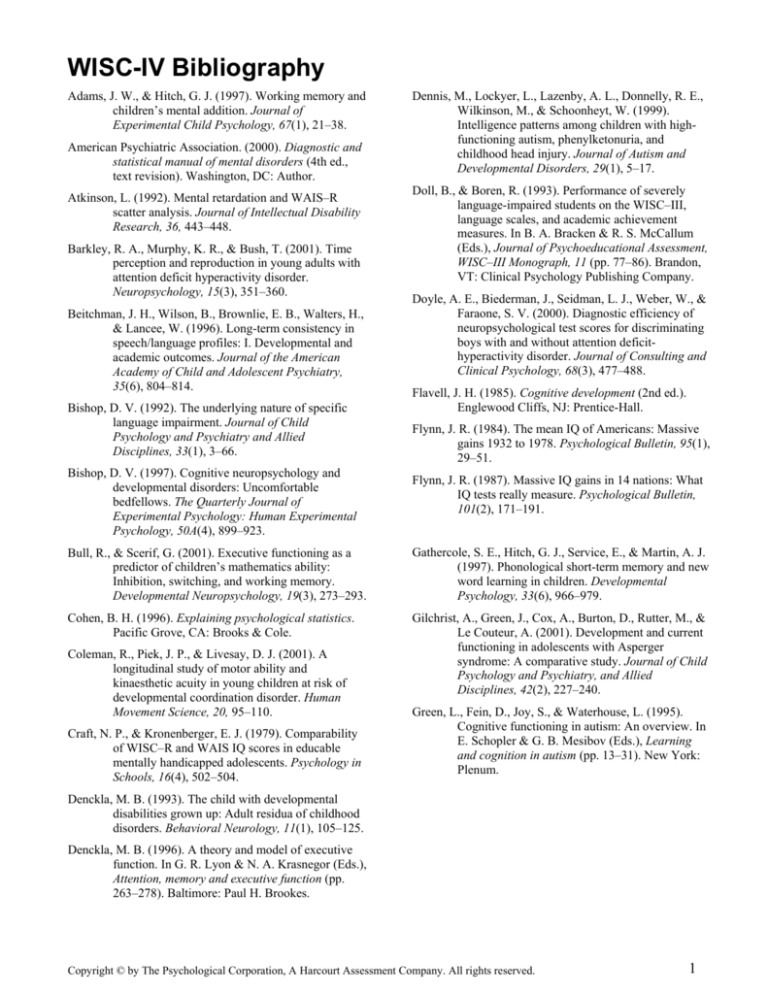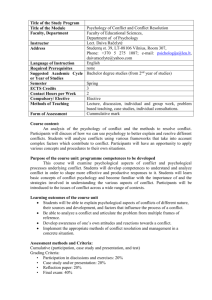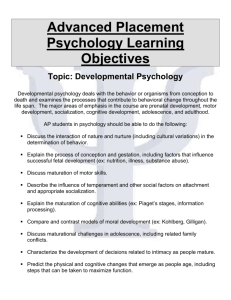
WISC-IV Bibliography
Adams, J. W., & Hitch, G. J. (1997). Working memory and
children’s mental addition. Journal of
Experimental Child Psychology, 67(1), 21–38.
American Psychiatric Association. (2000). Diagnostic and
statistical manual of mental disorders (4th ed.,
text revision). Washington, DC: Author.
Atkinson, L. (1992). Mental retardation and WAIS–R
scatter analysis. Journal of Intellectual Disability
Research, 36, 443–448.
Barkley, R. A., Murphy, K. R., & Bush, T. (2001). Time
perception and reproduction in young adults with
attention deficit hyperactivity disorder.
Neuropsychology, 15(3), 351–360.
Beitchman, J. H., Wilson, B., Brownlie, E. B., Walters, H.,
& Lancee, W. (1996). Long-term consistency in
speech/language profiles: I. Developmental and
academic outcomes. Journal of the American
Academy of Child and Adolescent Psychiatry,
35(6), 804–814.
Bishop, D. V. (1992). The underlying nature of specific
language impairment. Journal of Child
Psychology and Psychiatry and Allied
Disciplines, 33(1), 3–66.
Bishop, D. V. (1997). Cognitive neuropsychology and
developmental disorders: Uncomfortable
bedfellows. The Quarterly Journal of
Experimental Psychology: Human Experimental
Psychology, 50A(4), 899–923.
Dennis, M., Lockyer, L., Lazenby, A. L., Donnelly, R. E.,
Wilkinson, M., & Schoonheyt, W. (1999).
Intelligence patterns among children with highfunctioning autism, phenylketonuria, and
childhood head injury. Journal of Autism and
Developmental Disorders, 29(1), 5–17.
Doll, B., & Boren, R. (1993). Performance of severely
language-impaired students on the WISC–III,
language scales, and academic achievement
measures. In B. A. Bracken & R. S. McCallum
(Eds.), Journal of Psychoeducational Assessment,
WISC–III Monograph, 11 (pp. 77–86). Brandon,
VT: Clinical Psychology Publishing Company.
Doyle, A. E., Biederman, J., Seidman, L. J., Weber, W., &
Faraone, S. V. (2000). Diagnostic efficiency of
neuropsychological test scores for discriminating
boys with and without attention deficithyperactivity disorder. Journal of Consulting and
Clinical Psychology, 68(3), 477–488.
Flavell, J. H. (1985). Cognitive development (2nd ed.).
Englewood Cliffs, NJ: Prentice-Hall.
Flynn, J. R. (1984). The mean IQ of Americans: Massive
gains 1932 to 1978. Psychological Bulletin, 95(1),
29–51.
Flynn, J. R. (1987). Massive IQ gains in 14 nations: What
IQ tests really measure. Psychological Bulletin,
101(2), 171–191.
Bull, R., & Scerif, G. (2001). Executive functioning as a
predictor of children’s mathematics ability:
Inhibition, switching, and working memory.
Developmental Neuropsychology, 19(3), 273–293.
Gathercole, S. E., Hitch, G. J., Service, E., & Martin, A. J.
(1997). Phonological short-term memory and new
word learning in children. Developmental
Psychology, 33(6), 966–979.
Cohen, B. H. (1996). Explaining psychological statistics.
Pacific Grove, CA: Brooks & Cole.
Gilchrist, A., Green, J., Cox, A., Burton, D., Rutter, M., &
Le Couteur, A. (2001). Development and current
functioning in adolescents with Asperger
syndrome: A comparative study. Journal of Child
Psychology and Psychiatry, and Allied
Disciplines, 42(2), 227–240.
Coleman, R., Piek, J. P., & Livesay, D. J. (2001). A
longitudinal study of motor ability and
kinaesthetic acuity in young children at risk of
developmental coordination disorder. Human
Movement Science, 20, 95–110.
Craft, N. P., & Kronenberger, E. J. (1979). Comparability
of WISC–R and WAIS IQ scores in educable
mentally handicapped adolescents. Psychology in
Schools, 16(4), 502–504.
Green, L., Fein, D., Joy, S., & Waterhouse, L. (1995).
Cognitive functioning in autism: An overview. In
E. Schopler & G. B. Mesibov (Eds.), Learning
and cognition in autism (pp. 13–31). New York:
Plenum.
Denckla, M. B. (1993). The child with developmental
disabilities grown up: Adult residua of childhood
disorders. Behavioral Neurology, 11(1), 105–125.
Denckla, M. B. (1996). A theory and model of executive
function. In G. R. Lyon & N. A. Krasnegor (Eds.),
Attention, memory and executive function (pp.
263–278). Baltimore: Paul H. Brookes.
Copyright © by The Psychological Corporation, A Harcourt Assessment Company. All rights reserved.
1
Greiffenstein, M. F., & Baker, W. J. (2002).
Neuropsychological and psychosocial correlates
of adult arithmetic deficiency. Neuropsychology,
16(4), 451–458.
Hinshaw, S. P., Carte, E. T., Sami, N., Treuting, J. J., &
Zupan, B. A. (2002). Preadolescent girls with
attentiondeficit/hyperactivity disorder II:
Neuropsychological performance in relation to
subtypes and individual classification. Journal of
Consulting and Clinical Psychology, 70(5), 1099–
1111.
Korkman, M., & Pesonen, A. (1994). A comparison of
neuropsychological test profiles of children with
attention deficit-hyperactivity disorder and/or
learning disorder. Journal of Learning
Disabilities, 27(6), 383–392.
Lezak, M. D. (1995). Neuropsychological assessment (3rd
ed.). New York: Oxford University Press.
Lord, R., & Hulme, C. (1987). Kineasthetic sensitivity of
normal and clumsy children. Developmental
Medicine and Child Neurology, 29(6), 720–725.
Mayes, S. D., Calhoun, S. L., & Crowell, E. W. (1998a).
WISC–III freedom from distractibility as a
measure of attention in children with and without
attention deficit hyperactivity disorder. Journal of
Attention Disorders, 2(4), 217–227.
Mayes, S. D., Calhoun, S. L., & Crowell, E. W. (1998b).
WISC–III profiles for children with and without
learning disabilities. Psychology in the Schools,
35(4), 309–316.
Mayes, S. D., Calhoun, S. L., & Crowell, E. W. (2000).
Learning disabilities and ADHD: Overlapping
spectrum disorders. Journal of Learning
Disabilities, 33(5), 417–424.
Miller, J. N., & Ozonoff, S. (2000). The external validity
of Asperger disorder: Lack of evidence from the
domain of neuropsychology. Journal of Abnormal
Psychology, 109(2), 227–238.
Pennington, B. F., Bennetto, L., McAleer, O., & Roberts,
R. J. (1996). Executive functions and working
memory. In G. R. Lyons & N. A. Krasnegor
(Eds.), Attention, memory and executive function
(pp. 327–348). Baltimore: Paul H. Brookes.
Pennington, B. P., & Ozonoff, S. (1996). Executive
functions and developmental psychopathology.
Journal of Child Psychology and Psychiatry,
37(1), 51–87.
Phelps, L. (1998). Utility of the WISC–III for children with
language impairments. In A. Prifitera & D.
Saklofske (Eds.), WISC–III clinical use and
interpretation: Scientist-practitioner perspectives
(pp. 157–173). San Diego: Academic Press.
analysis. Developmental Neuropsychology, 8(4),
413–426.
Seidman, L. J., Biederman, J., Monuteaux, M. C., Doyle,
A. E., & Faraone, S. V. (2001). Learning
disabilities and executive dysfunction in boys
with attentiondeficit/hyperactivity disorder.
Neuropsychology, 15(4), 544–556.
Siegel, D. J., Minshew, N. J., & Goldstein, G. (1996).
Wechsler IQ profiles in diagnosis of highfunctioning autism. Journal of Autism and
Developmental Disorders, 26(4), 389–406.
Sparrow, S., & Gurland, S. T. (1998). Assessment of gifted
children with the WISC–III. In A. Prifitera & D.
H. Saklofske (Eds.), WISC–III clinical use and
interpretation: Scientist-practitioner perspectives
(pp. 59–72). San Diego: Academic Press.
Spruill, J. (1991). A comparison of the Wechsler adult
intelligence scale–revised with the Stanford-Binet
intelligence scale (fourth edition) for mentally
retarded adults. Psychological Assessment: A
Journal of Consulting and Clinical Psychology,
3(1), 1–3.
Swanson, H. L., & Howell, M. (2001). Working memory,
short-term memory, and speech rate as predictors
of children’s reading performance at different
ages. Journal of Educational Psychology, 9(4),
720–734.
Swanson, H. L., Mink, J., & Bocian, K. M. (1999).
Cognitive processing deficits in poor readers with
symptoms of reading disabilities and ADHD:
More alike than different? Journal of Educational
Psychology, 91(2), 321–333.
Tremont, G., Mittenberg, W., & Miller, L. J. (1999). Acute
intellectual effects of pediatric head trauma. Child
Neuropsychology, 5(2), 104–114.
Watkins, M. W., Greenawalt, C. G., & Marcell, C. M.
(2002). Factor structure of the Wechsler
intelligence scale for children—third edition
among gifted students. Educational and
Psychological Measurement, 62(1), 164–172.
Wechsler, D. (1991). The Wechsler intelligence scale for
children—third edition. San Antonio, TX: The
Psychological Corporation.
Wechsler, D. (2002). Wechsler preschool and primary
scale of intelligence—third edition. San Antonio,
TX: The Psychological Corporation.
Willcutt, E. G., Pennington, B. F., Boada, R., Ogline, J. S.,
Tunick, R. A., Chhabildas, N. A., & Olson, R. K.
(2001). A comparison of the cognitive deficits in
reading disability and attentiondeficit/hyperactivity disorder. Journal of
Abnormal Psychology, 110(1), 157–172.
Rose, J. C., Lincoln, A. J., & Allen, M. H. (1992). Ability
profiles of developmental language disordered
and learning disabled children: A comparative
Copyright © by The Psychological Corporation, A Harcourt Assessment Company. All rights reserved.
2






